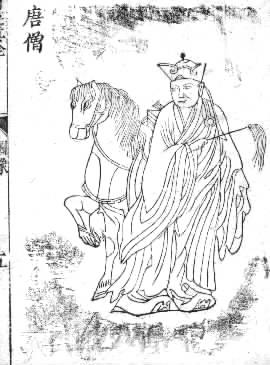Abhidharma-mahāvibhāṣā
(Redirected from Mahavibhasa)
Jump to navigation
Jump to search

The Chinese monk Xuanzang, who translated the Mahavibhasa into Chinese.
Abhidharma-mahāvibhāṣā (T. chos mngon pa bye brag bshad pa chen po; C. Apidamo dapiposha lun 阿毘達磨大毘婆沙論), also known as Mahāvibhāṣā, is a treatise on the Sarvastivada Abhidharma composed in the ancient Kashmiri region of northern India some time prior to 656 C.E. The text was translated into Chinese by the scholar–pilgrim Xuanzang between 656 and 659 C.E.[1] No Sanskrit version of this text is extant.[1]
Jan Westerhoff states:
- A second extremely important Sarvāstivāda text is the Abhidharma-mahāvibhāṣa (or Vibhāṣā for short), a gigantic work said to have been compiled by a council of Kashmirian Sarvāstivādin monks during the time of King Kaniṣka. Because the authority of the Vibhāṣā was so central for the Kashmirian Sarvāstivādins they were also referred to as Vaibhāṣikas, or ‘commentarians’. The Vibhāṣā follows the structure of the Jñānaprasthāna, for which it acts as a commentary. However, this work is best understood not as a commentary, but as an encyclopedic work comprising a wide range of early Buddhist viewpoints; not simply orthodox Sarvāstivāda tenets but also viewpoints of other Sarvāstivāda teachers, and doctrines of rival Buddhist schools. It frequently lists the positions of the four great Sarvāstivāda masters (Dharmatrāta, Buddhadeva, Ghoṣaka, and Vasumitra), often declaring Vasumitra’s position as the best.[2]
The title
The title is translated as follows:
- English: Great Exegesis of Abhidharma
- Tibetan: Chos mngon pa bye brag bshad pa chen po
- Chinese: Apidamo dapiposha lun 阿毘達磨大毘婆沙論
- Japanese: Abidatsuma daibibasharon
- Korean: Abidalma taebibasa non
Contents
The Mahāvibhāṣā is divided into eight sections (grantha) which correspond to the eight sections of the Jñānaprasthāna.[1]
- Coverage of each topic begins with an overview of varying interpretations found in different Buddhist and non-Buddhist schools, detailed coverage of the positions of the four major Sarvāstivāda Ābhidharmikas, and finally the definitive judgment of the compilers, the Kāśmīri followers of KātyāyanĪputra, who call themselves the Vibhāṣāśāstrins. The Mahāvibhāṣā was the major influence on the systematic scholastic elaboration of Sarvāstivāda doctrine that appears (though with occasional intrusions from the positions of the Sarvāstivāda’s more-progressive Sautrāntika offshoot) in Vasubandhu's influential Abhidharmakośabhāṣya, which itself elicited a spirited response from later Sarvāstivāda–Vaibhāṣika scholars, such as Saṃghabhadra in his *Nyāyānusāra.[1]
Modern translation into Tibetan
The Princeton Dictionary states:
- The Mahāvibhāṣa was not translated into Tibetan until the twentieth century, when a translation entitled Bye brag bshad mdzod chen mo was made at the Sino-Tibetan Institute by the Chinese monk Fazun between 1946 and 1949. He presented a copy of the manuscript to the young fourteenth Dalai Lama on the Dalai Lama’s visit to Beijing in 1954...[1]
Phillip Stanely states:
- In 1949, the Chinese monk Fazun (1902–1980) completed the monumental task of translating the Chinese translation of the Mahāvibhāṣa into Tibetan, which was published separately in ten volumes in 2011.[3]
References
- ↑ 1.0 1.1 1.2 1.3 1.4 Buswell & Lopez 2014, s.v. Abhidharmamahāvibhāṣa.
- ↑ Westerhoff 2018, "The Abhidharma Schools".
- ↑ Stanley 2014, p. 405.
Sources
 Buswell, Robert E.; Lopez, Donald S. (2014), The Princeton Dictionary of Buddhism, Princeton University
Buswell, Robert E.; Lopez, Donald S. (2014), The Princeton Dictionary of Buddhism, Princeton University- Stanley, Phillip (2014), "The Tibetan Buddhist Canon", The Wiley Blackwell Companion to East and Inner Asian Buddhism, John Wiley & Sons
 Westerhoff, Jan (2018), The Golden Age of Indian Buddhist Philosophy, Oxford University Press
Westerhoff, Jan (2018), The Golden Age of Indian Buddhist Philosophy, Oxford University Press
External links
 Mahavibhasa, Wikipedia
Mahavibhasa, Wikipedia